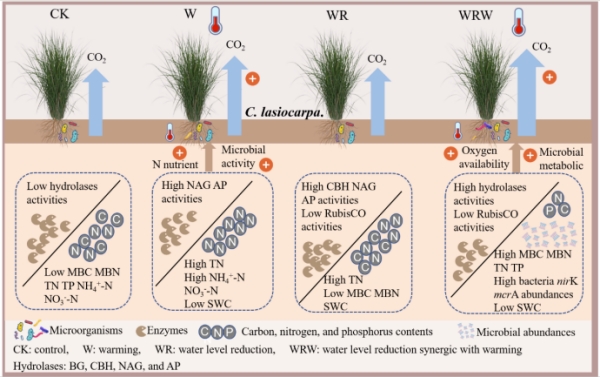Temperature and water level changes are known to impact wetland CO2 emissions, the underlying mechanisms governing how marsh wetlands respond to the combined effect of these two factors remain poorly understood. This knowledge gap poses a challenge for accurately predicting wetland carbon dynamics and formulating effective climate mitigation strategies.
The research group led by SONG Yanyu from the Northeast Institute of Geography and Agroecology, CAS, revealed the CO2 emissions characteristics and their driving mechanisms in marsh wetlands of the Sanjiang Plain under different temperature and water condition using the in situ open-top chamber (OTC) passive warming combined with the automatic water level control platform. This work was published in the journal of Applied Soil Ecology on 29 August.
The study revealed that warming and combined warming and water level reduction significantly promoted marsh wetland CO2 emissions. Soil hydrolases activities and microbial biomass contents were the dominant controlling factors for CO2 emissions under different temperature and water condition. Combined warming and water level reduction stimulated soil β-glucosidase, cellobiohydrolase, N-acetyl-β-glucosaminidase, and acid phosphatase activities and increased soil MBC, MBN contents by increasing oxygen availability, thereby accelerating organic matter decomposition and promoting CO2 emissions. Air temperature, soil temperature, plant height, and chlorophyll content are important factors driving the seasonal variations of CO2 flux.
This study provides fundamental data for simulating and predicting climate change and controlling carbon emission by regulating water level in the future. Additionally, they serve as important theoretical basis for enhancing and adjusting the carbon sink function of wetland ecosystems.

Fig. 1. Driving mechanisms of CO2 emissions in marsh wetlands of the Sanjiang Plain under different temperature and water condition.
Keywords:
Carbon dioxide, Soil enzyme activities, Soil microbial abundances, Warming, Water level
Contact:
SONG Yanyu
Northeast Institute of Geography and Agroecology, Chinese Academy of Sciences
E-mail: songyanyu@iga.ac.cn
Attachment:
Soil hydrolases and microbial biomass regulate wetland CO2 emissions under warming and water level reduction
https://doi.org/10.1016/j.apsoil.2025.106387